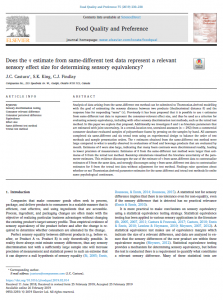Does the τ estimate from same-different test data represent a relevant sensory effect size for determining sensory equivalency?
 Analysis of data arising from the same-different test method can be submitted to Thurstonian-derived modelling with the goal of estimating the sensory distance between two products (the discriminal distance δ) and the response bias for responding “same” (τ). Previously it has been proposed that it is possible to use τ estimates from same-different test data to represent the consumer-relevant effect size, and thus be used as a criterion for evaluating sensory equivalency, including with other sensory discrimination test methods, such as the tetrad test method. In this paper we explore that proposal.
Analysis of data arising from the same-different test method can be submitted to Thurstonian-derived modelling with the goal of estimating the sensory distance between two products (the discriminal distance δ) and the response bias for responding “same” (τ). Previously it has been proposed that it is possible to use τ estimates from same-different test data to represent the consumer-relevant effect size, and thus be used as a criterion for evaluating sensory equivalency, including with other sensory discrimination test methods, such as the tetrad test method. In this paper we explore that proposal.
Additionally we investigate δ and τ as bivariate parameters that are estimated with joint uncertainty. In a central-location test, untrained assessors (n=292) from a commercial consumer database evaluated samples of polyurethane foams by pressing on the samples by hand. All assessors completed six same-different and six tetrad tests using an experimental design to balance the order of test methods and sample presentation orders. The τ estimates obtained from the same-different test method were large compared to what is usually observed in evaluations of food and beverage products that are evaluated by mouth. Estimates of δ were also large, indicating that many foam contrasts were discriminated readily, leading to lower precision of measurement. Estimates of δ from the same-different test method were larger than estimates of δ from the tetrad test method. Bootstrap simulations visualized the bivariate uncertainty of the parameter estimates. This evidence discourages the use of the estimate of τ from same-different data to contextualize estimates of δ from the same data, and strongly discourages using τ from same-different test data to contextualize estimates for δ from the tetrad test data without adjustment for test method. Findings raise questions about whether or not Thurstonian-derived parameter estimates for the same-different and tetrad test methods lie on the same psychological continuum.
![]()
Castura, J.C., King, S.K., & Findlay, C.J. (2019). Does the τ estimate from same-different test data represent a relevant sensory effect size for determining sensory equivalency? Food Quality and Preference, 75, 230-238. https://doi.org/10.1016/j.foodqual.2019.02.014